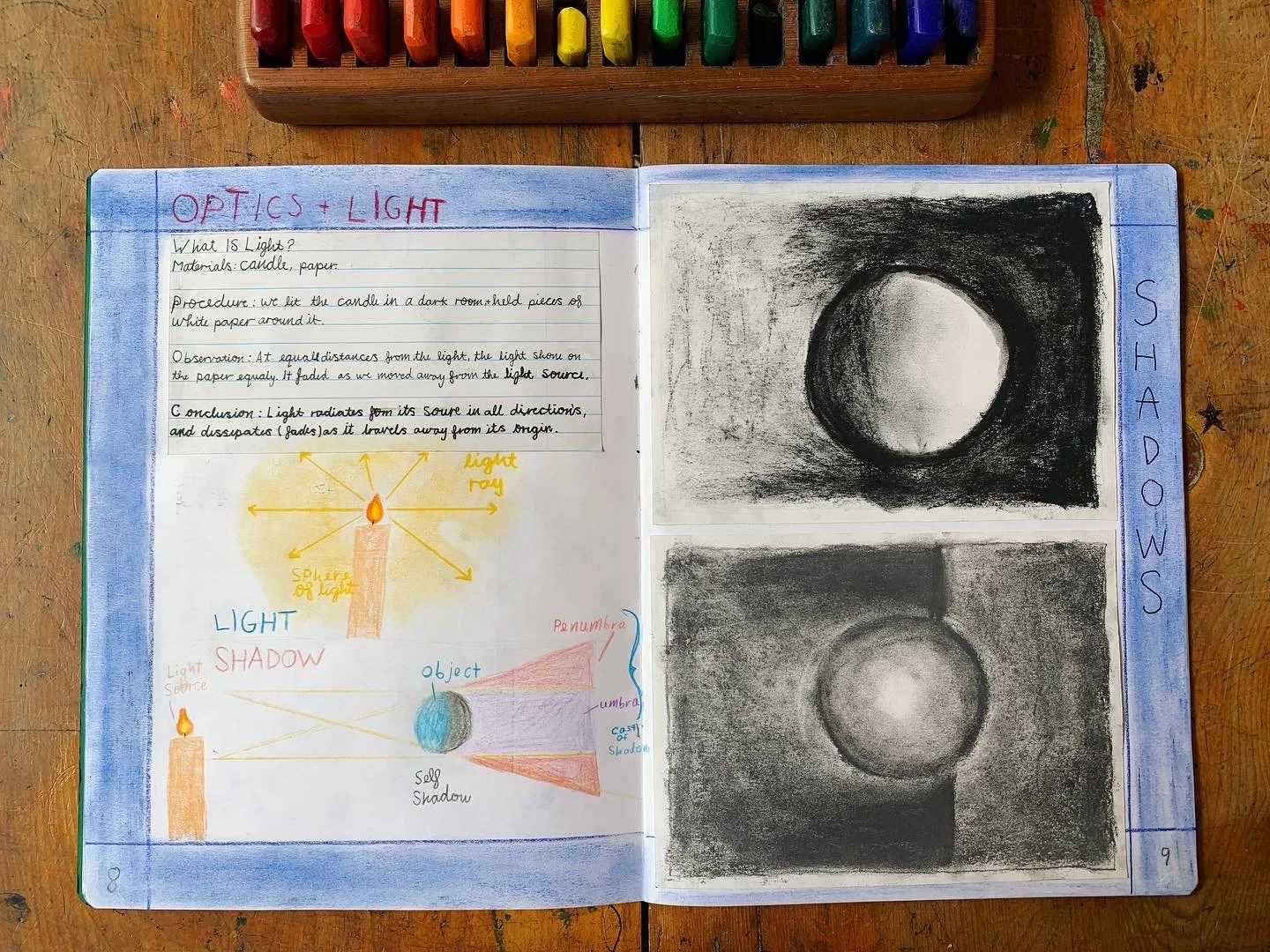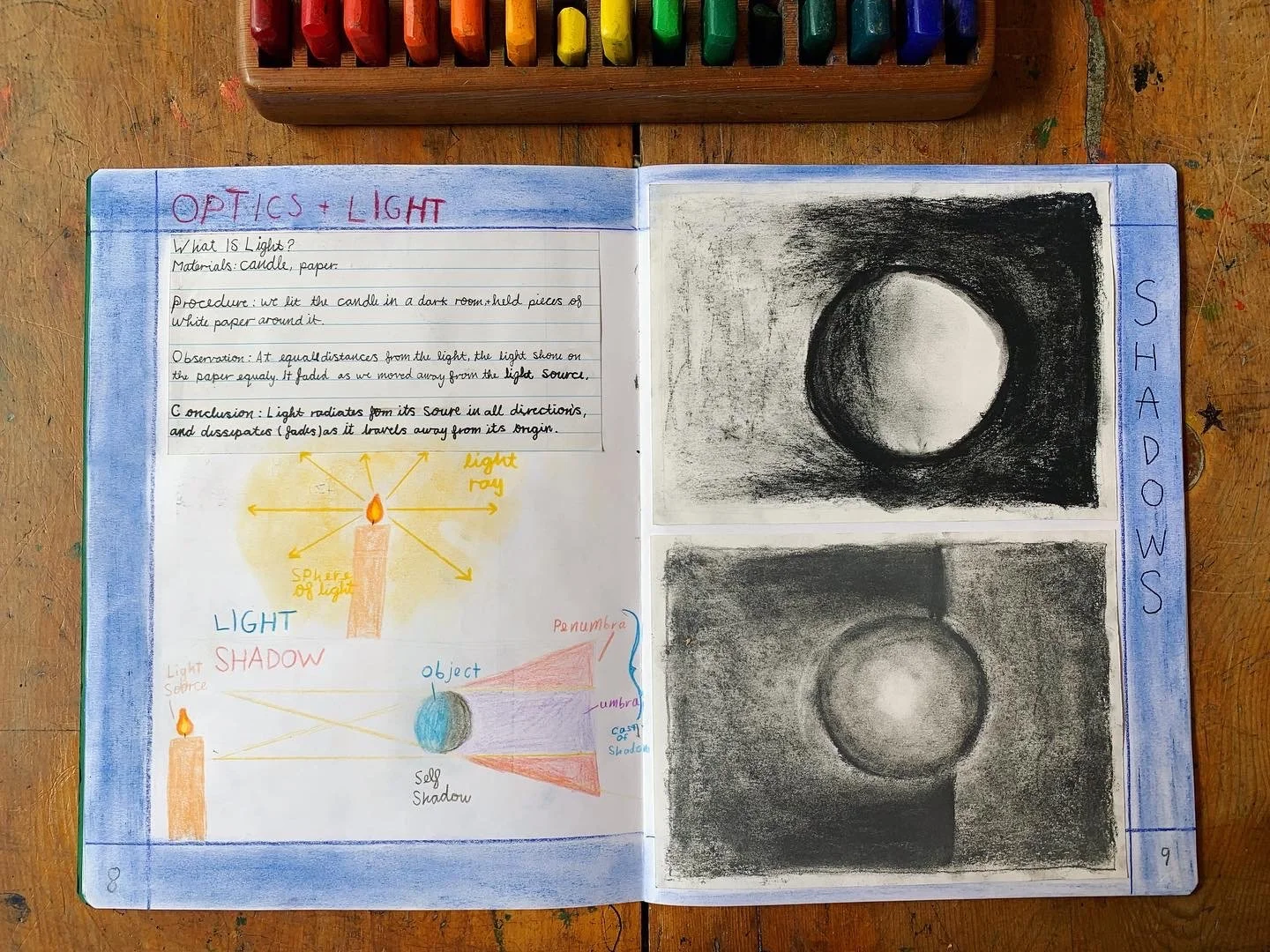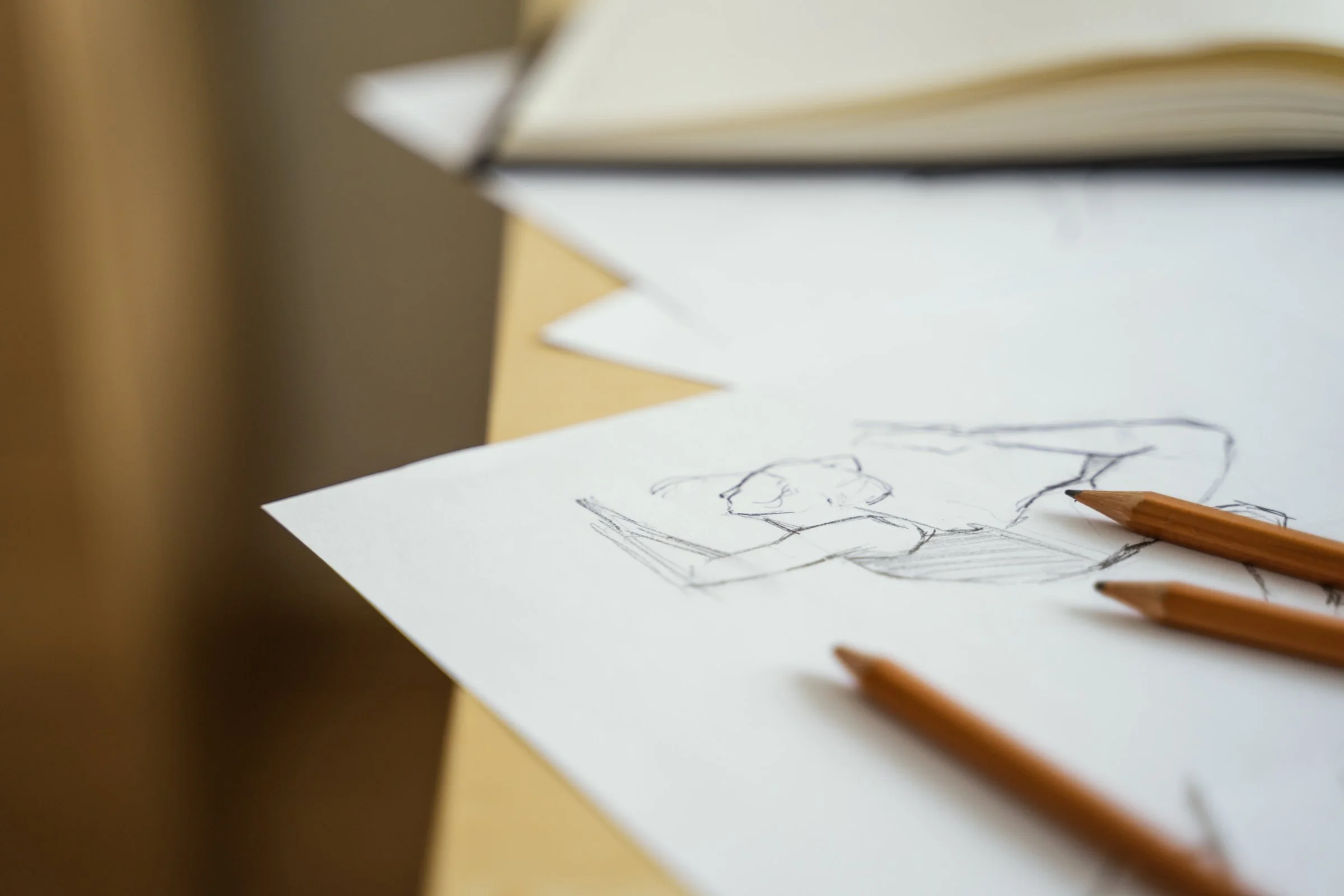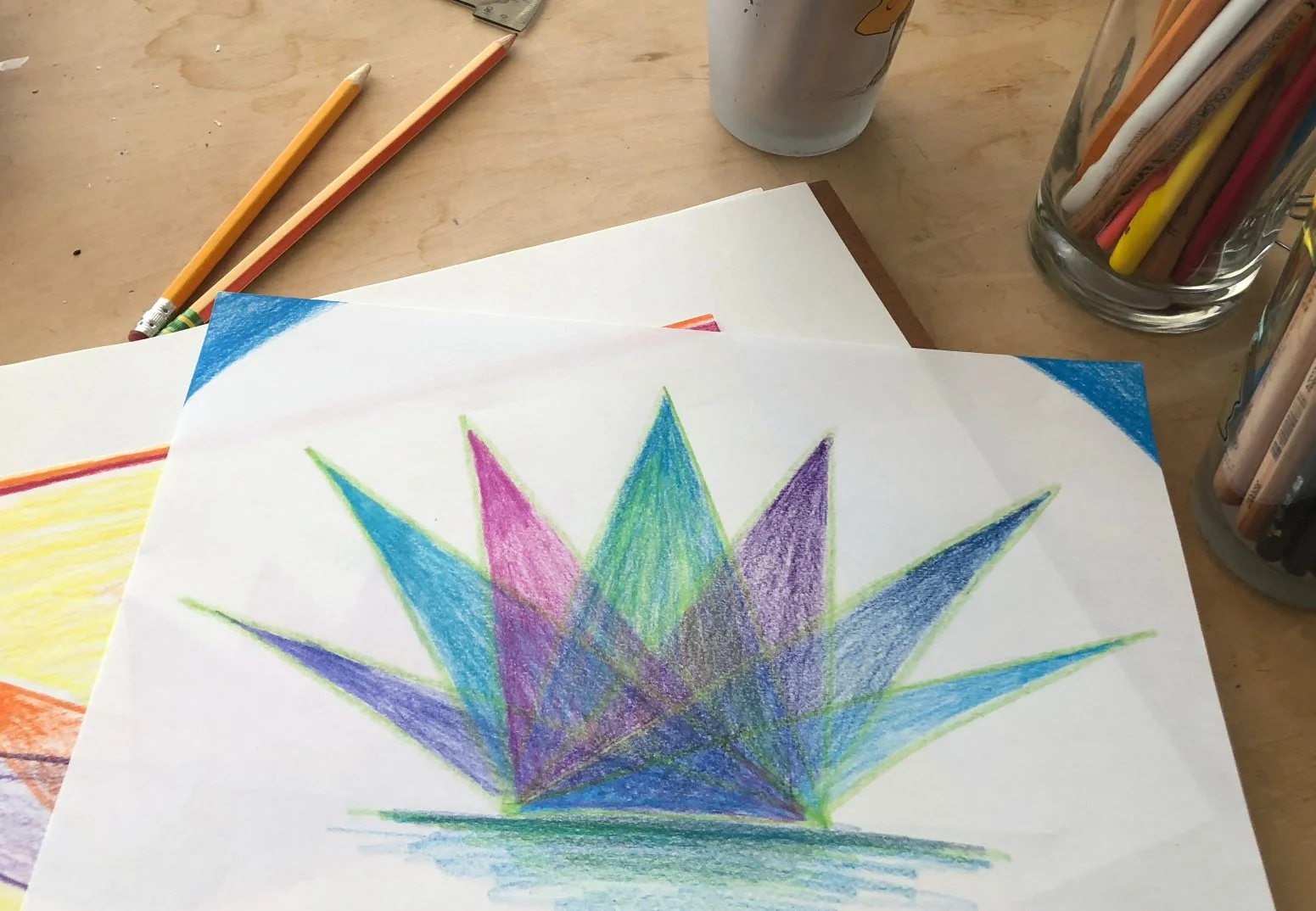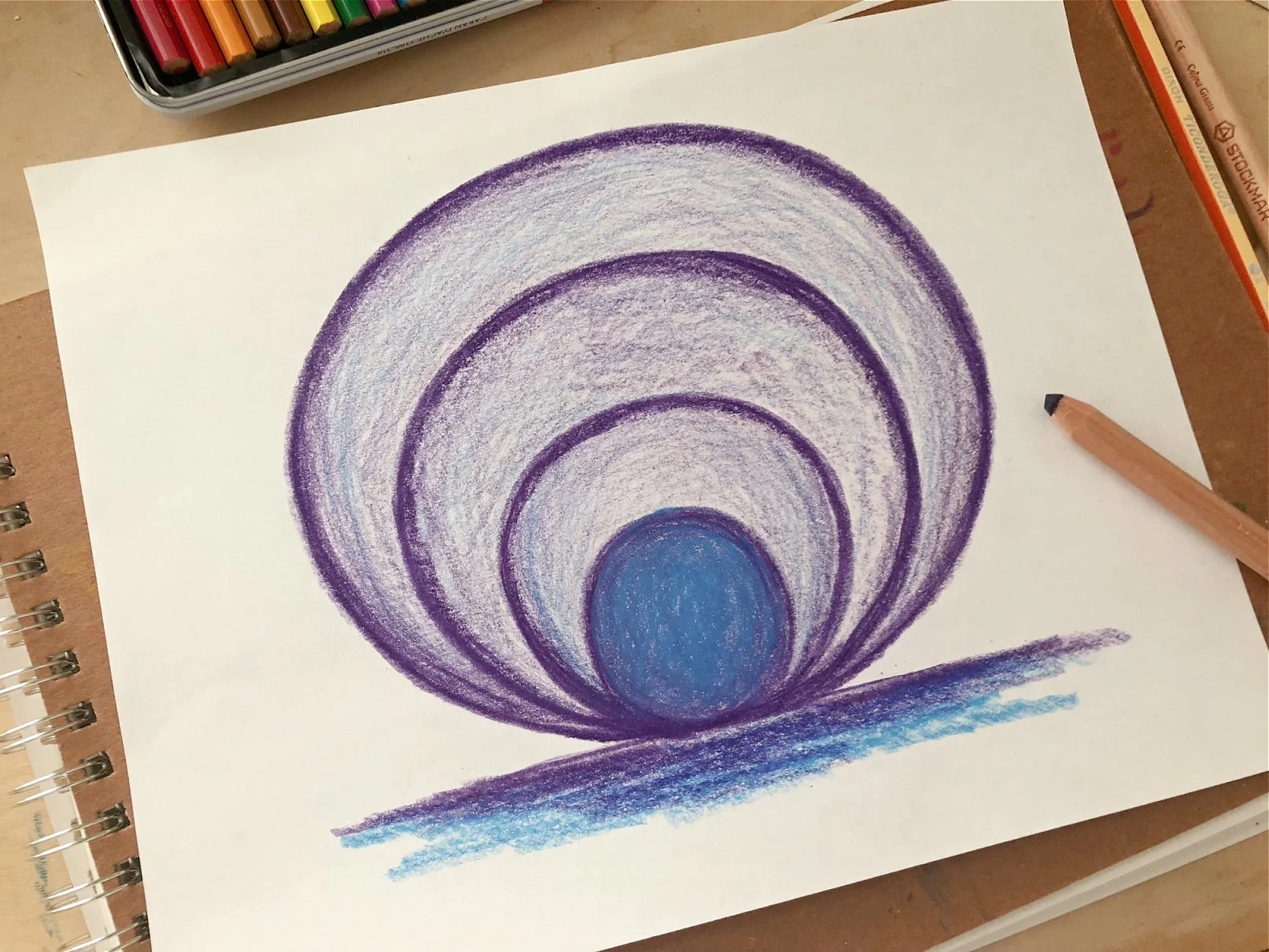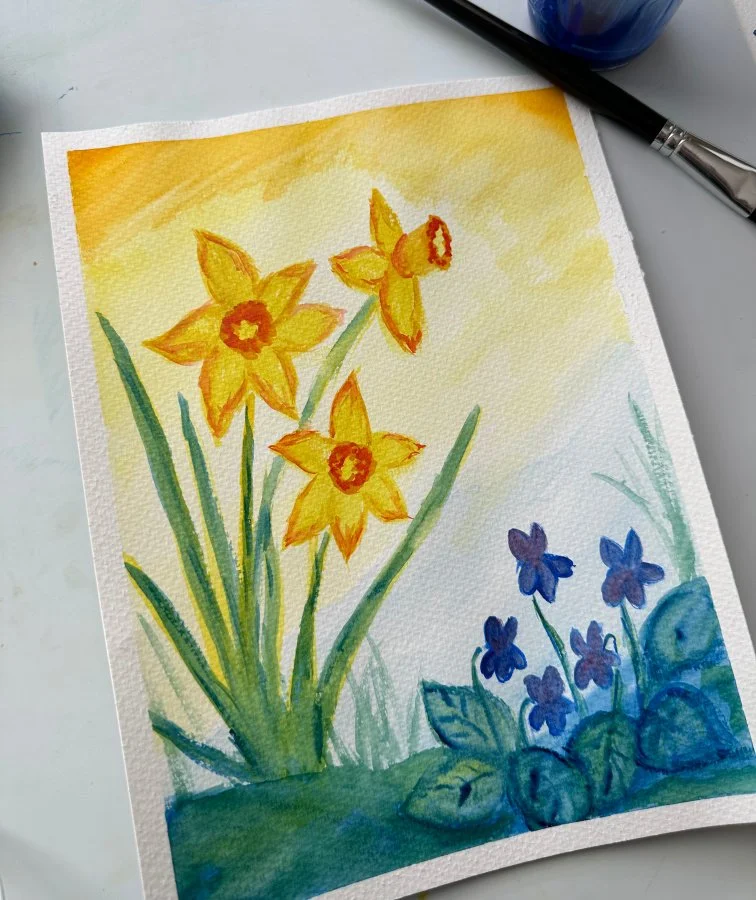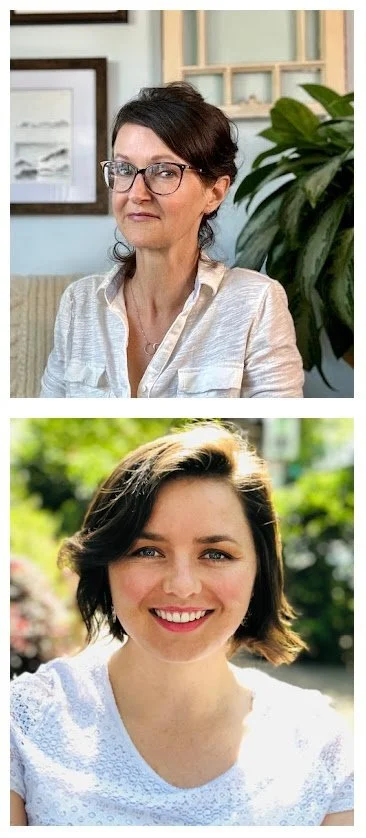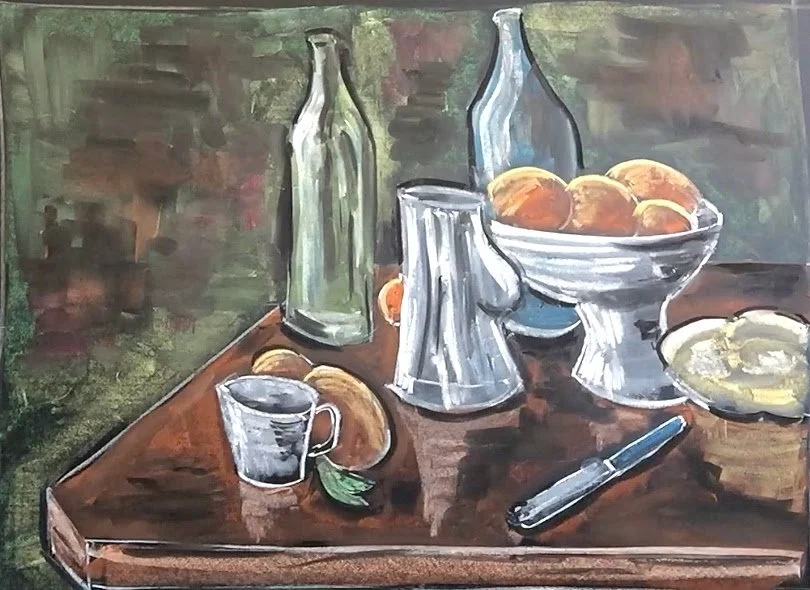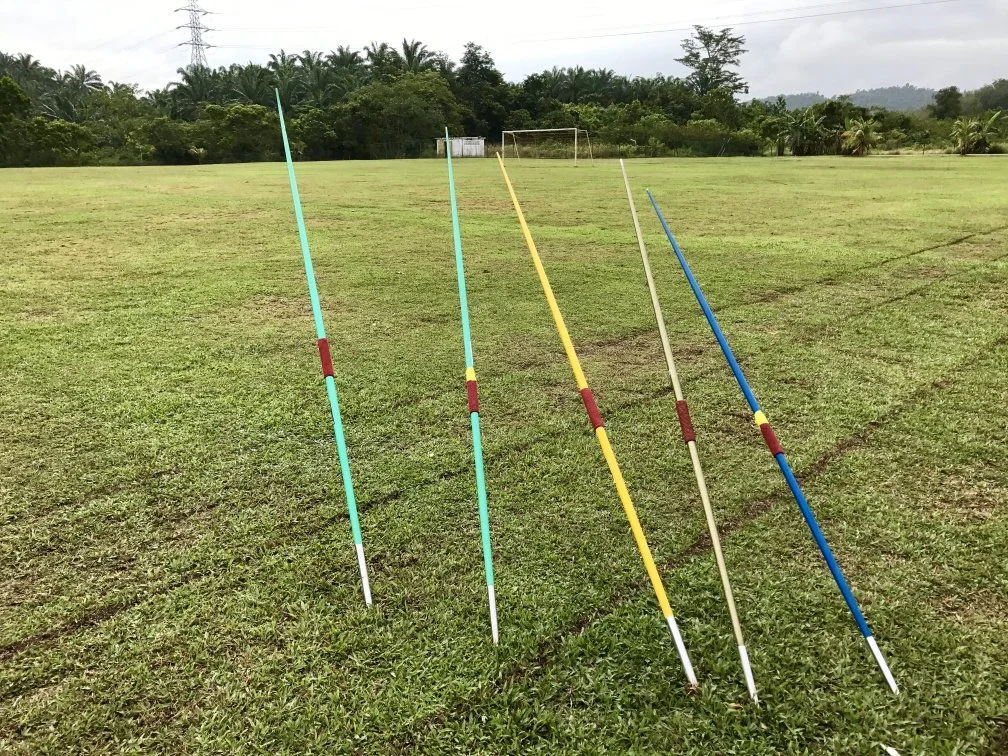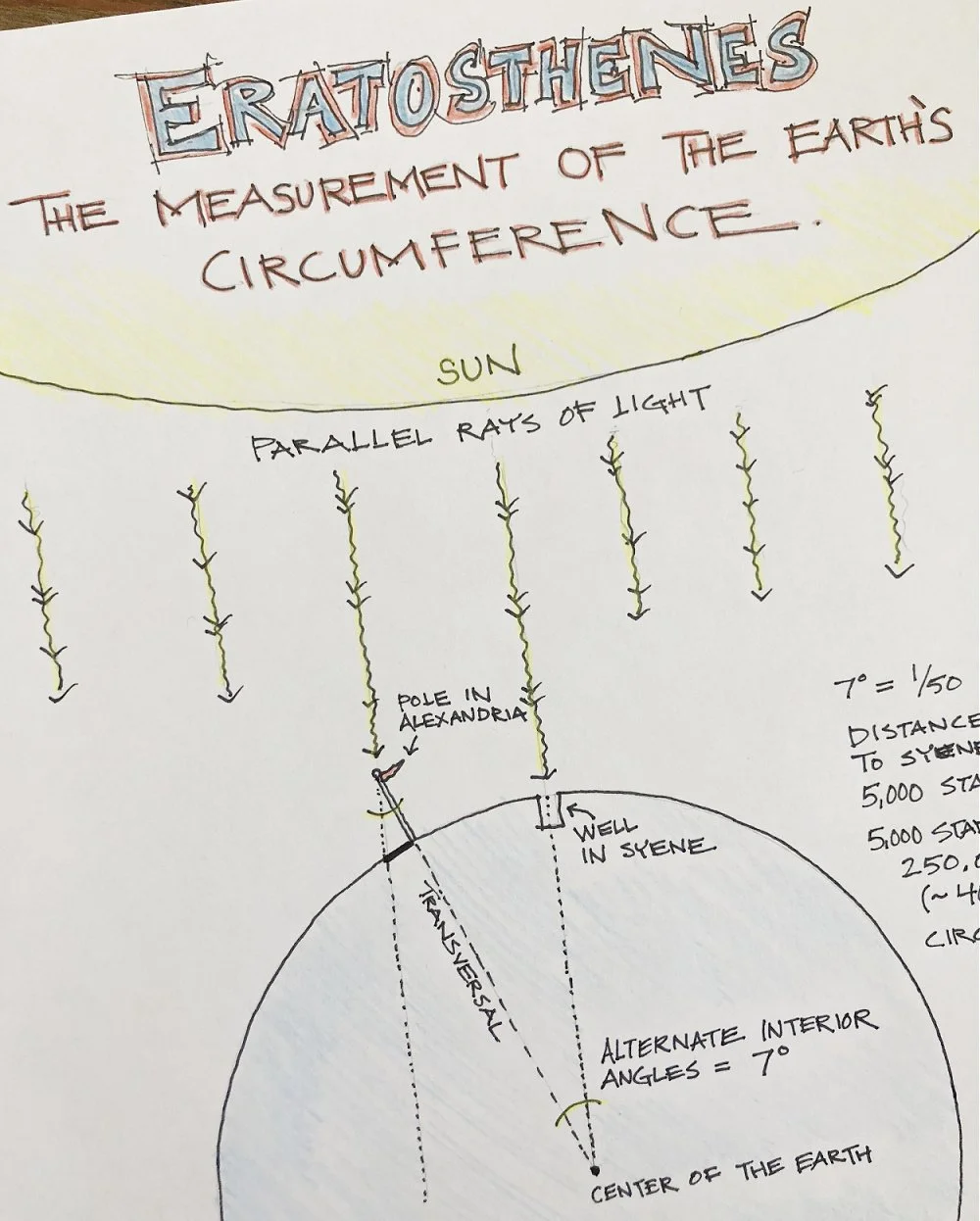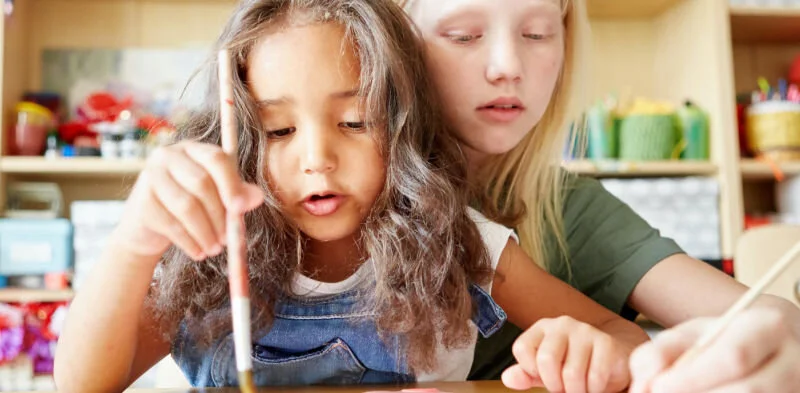
Waldorfish Blog
Waldorf Sixth Grade Curriculum: Exploring the Natural World through Physics
In sixth grade, it’s time for a whole new way of exploring the natural world: the study of Physics!
As the child is leaving the comforting world of early childhood and entering into a new realm, it’s the perfect time to re-enliven and re-invigorate their sense of awe and love for the natural world, all while discovering scientific phenomena and law.
An example main lesson book page illustrating experiments around Optics, from our sixth grade Physics course!
While a Waldorf student has been exploring nature throughout the grades, middle school marks a shift in the curriculum where scientific study becomes far more structured and a key area of focus. These blocks call upon the educator to teach in a new way using phenomenology (Huh? Click here for more) and for the student to approach their learning from a different perspective.
So, what’s sixth grade physics all about? The block starts with the basics, and calls upon the student to use their observational and practical skills to discover the laws of sound, heat, light, magnetism, and electricity.
The curriculum typically begins with the study of acoustics, where students explore the nature of sound. They learn how sound is produced by vibrations and how it travels through different materials. Through activities involving musical instruments and simple sound experiments, students investigate phenomena like pitch, echo, and resonance.
The curriculum also introduces students to the principles of heat and thermodynamics. They examine how heat is generated, how it moves, and how it affects materials—causing them to expand, contract, or change state. This is a particularly fun aspect of the block; seeing an educator use a blowtorch is always exciting (when done safely, of course!)
The study of magnetism in action!
When studying optics (also referred to as the study of light) students observe the characteristics of light and how it behaves in our world. With the use of a completely blacked out room, students observe how light is invisible, how it can create a camera obscura, and explore the vast world of color and shadow.
Magnetism is explored through the use of simple magnets and iron filings, allowing students to observe magnetic attraction and repulsion, and the concept of magnetic fields. They experiment with magnetic materials and learn about the basic properties of magnets, including polarity.
Finally, students are given an introductory look at static electricity using balloons, various kinds of fabric and textiles, and other materials. Though explored simply, this portion is setting the stage for 8th grade physics when students will build motors, explore circuits, and more!
This 6th grade Physics block sets the foundation for the future as the curriculum deepens in complexity, where physics will be visited again in 7th and 8th grade.
It’s an exciting shift where the educator and student enter a new realm of observation, investigation and exploration!
More on the blog:
About the Authors
Robyn Beaufoy is Waldorfish’s CEO, and also a course instructor for Simple Season, Waldorf Art for Beginners, and Weekly Art Foundations. You’ll find her intuitive touches and influences throughout everything Waldorfish offers. Robyn has been in the world of education for over 25 years, with an MA in Education and a certification in Waldorf teaching - she also homeschooled both of her children for some of that time. In 2012 Robyn co-founded Waldorfish.com, creating it with the vision of making Waldorf inspired-art and pedagogy more accessible, joyful, and doable for homeschoolers all over the world.
Caitlin Amajor is Waldorfish’s course instructor for Geometry grades 5 & 6, and Botany, as well as our Administrative Assistant. From a young age, Caitlin has been immersed in Waldorf education, attending a Waldorf school from K-8. After receiving a BA in History, Caitlin gained her certification in Waldorf teaching, and spent seven years as a Waldorf class teacher in the upper grades. With a special fondness for watercolor painting and geometry, Caitlin loves bringing Waldorf education to her students all over the world, and seeing their own individuality and style bloom from the curriculum!
Waldorf Botany Curriculum: Shifting Focus to the Higher Plants
A watercolor painting of the “higher plants” from our Botany course!
In Waldorf fifth grade botany, the second block focuses on the “higher plants,” or those that have true leaves, roots, stems, and flowers!
(To learn more about the first block and its focus, click here).
The second block, often done in the spring, is the perfect time to study these more complex plants with new methods.
Why?
The curriculum meets the developing fifth grader right where they are, which is on the cusp of entering middle school!
The growing fifth grader is ready to use their observational skills in more complex and challenging ways, and the educator can begin to introduce concepts using phenomenological techniques, preparing them for middle school science curriculum.
The shift in the Botany curriculum is notable; the fifth grader is no longer living so much in the world of imagination and story, but instead, is eager to explore and learn more about the world around them.
In Botany, the second block closely follows the growth of a plant from the very beginning. As the fifth grader is growing and changing rapidly, it’s the perfect time to connect with nature and see how it blossoms as well.
An example main lesson book page from our Botany course.
Commonly, students study seeds, germination, photosynthesis, flowering, and seed dispersal, all the while incorporating opportunities to connect to plant life thriving in their own region. As well, students may explore trees, categorize plants according to their characteristics (monocots and dicots), and so much more- the possibilities are endless!
This block provides an opportunity for the educator to bring the students directly into the learning process, and begin to nurture observational skills and the ability to come to educated conclusions.
It’s a time to do, feel, see, smell, taste, and use all of the senses to connect with the plant world!
From sprouting seeds, to dissecting flowers, the curriculum provides all kinds of opportunities to enliven the students’ connection to the vast world of Botany.
Wondering where to begin?
Most simply, and perhaps more meaningfully, start outside! Gain inspiration, connect with nature, and explore the beauty of the higher plants out in nature; it really is the best place to begin.
Our Botany course provides a full year’s worth of curriculum for the school year, including two full blocks, hands-on demonstrations, and so much more.
About the Authors
Robyn Beaufoy is Waldorfish’s CEO, and also a course instructor for Simple Season, Waldorf Art for Beginners, and Weekly Art Foundations. You’ll find her intuitive touches and influences throughout everything Waldorfish offers. Robyn has been in the world of education for over 25 years, with an MA in Education and a certification in Waldorf teaching - she also homeschooled both of her children for some of that time. In 2012 Robyn co-founded Waldorfish.com, creating it with the vision of making Waldorf inspired-art and pedagogy more accessible, joyful, and doable for homeschoolers all over the world.
Caitlin Amajor is Waldorfish’s course instructor for Geometry grades 5 & 6, and Botany, as well as our Administrative Assistant. From a young age, Caitlin has been immersed in Waldorf education, attending a Waldorf school from K-8. After receiving a BA in History, Caitlin gained her certification in Waldorf teaching, and spent seven years as a Waldorf class teacher in the upper grades. With a special fondness for watercolor painting and geometry, Caitlin loves bringing Waldorf education to her students all over the world, and seeing their own individuality and style bloom from the curriculum!
Learning through Recreating: What studying great artists has to teach us.
An important aspect of middle school art curriculum in Waldorf Education is providing opportunities for students to find their own artistic style.
A Matisse-inspired still life chalk drawing from our Weekly Art Foundations course.
One of the best ways to do this? Recreate the works of great artists from the past!
We realize this may sound counterintuitive; how can copying artwork from another artist help a middle schooler find their own style - isn’t it stifling their creativity?
In Waldorf education, the practice of studying and emulating master artists aligns beautifully with its holistic, experiential approach to learning. Learning through imitation lays a strong foundation for creative expression!
The imitation is not about rigid replication but about deeply experiencing artistic techniques, composition, and color in a hands-on way.
Just as a young musician learns by playing classical pieces before composing their own music, young artists build confidence and skill by studying the masters.
Just as so much of the Waldorf curriculum does in 7th grade, we take our cues from the artists of the Renaissance. When the artistic world was expanding quickly and household names such as Leonardo di Vinci, Michelangelo and Raphael were in their creative primes, one of the ways hopeful apprentices learned was to recreate the style, technique and subjects of these (and other) artists. This method aligns with the Waldorf developmental principle that learning is most effective when it is embodied and experienced.
Through the process of copying entire great works of art or specific techniques individually, students learn foundational skills required to create a beautiful and complete piece.
A chalk drawing inspired by Monet’s “Water Lilies” series, from our Weekly Art Foundations course.
From setting the base, finding the most pleasing composition, and mixing colors, studying the masters serves as a stepping stone to personal artistic expression.
As we have discovered again and again, a strong foundation provides the confidence and ability to branch out and find one’s own style; copying masterworks isn’t just about technique—it engages the hands, heart, and mind.
Waldorf education seeks to cultivate the whole child, and working with master artists' techniques allows students to feel the art, not just analyze it.
Recreating an artist’s work is the epitome of learning through doing, which is what Waldorf education is all about!
In our art courses, we include various lessons that do just this: take a well-known artist’s work and techniques, and recreate them. From Claude Monet to Alma Thomas, Vincent van Gogh, to figure drawing as Michaelangelo once did, our courses draw on inspiration from great artists of the past and awaken our students’ own creative forces in a deeply meaningful way.
About the Authors
Robyn Beaufoy is Waldorfish’s CEO, and also a course instructor for Simple Season, Waldorf Art for Beginners, and Weekly Art Foundations. You’ll find her intuitive touches and influences throughout everything Waldorfish offers. Robyn has been in the world of education for over 25 years, with an MA in Education and a certification in Waldorf teaching - she also homeschooled both of her children for some of that time. In 2012 Robyn co-founded Waldorfish.com, creating it with the vision of making Waldorf inspired-art and pedagogy more accessible, joyful, and doable for homeschoolers all over the world.
Caitlin Amajor is Waldorfish’s course instructor for Geometry grades 5 & 6, and Botany, as well as our Administrative Assistant. From a young age, Caitlin has been immersed in Waldorf education, attending a Waldorf school from K-8. After receiving a BA in History, Caitlin gained her certification in Waldorf teaching, and spent seven years as a Waldorf class teacher in the upper grades. With a special fondness for watercolor painting and geometry, Caitlin loves bringing Waldorf education to her students all over the world, and seeing their own individuality and style bloom from the curriculum!
More from Waldorfish!
Waldorf 5th Grade: Weaving Geometry Throughout the Curriculum
“The Crown” form found in our grade five geometry course.
Waldorf fifth grade curriculum includes a variety of subjects to explore.
It is particularly exciting because it is the first year history and science are introduced as stand-alone areas of study. Ancient Civilizations, Greek Mythologies and History, Botany, Decimals, and much more are explored using a variety of approaches, including (but not limited to!) art, music, and story.
One of our favorite aspects of the fifth grade curriculum is Geometry. Through a freehand approach, the fifth grader builds a strong relationship to geometry within their own bodies, and is prepared for the more complex work with tools that they will experience in sixth grade.
Geometry can be taught in block form in fifth grade (where the lessons are taught every school day over a three or four week period) and/or can also be sprinkled in throughout the school year - it is an ideal subject to be woven into other aspects of the curriculum.
Geometry fits in just about everywhere in the fifth grade year- here are several suggestions if you’re interested in weaving it all together:
Javelin throwing is a big part of the Pentathlon and can be a full-body way of exploring parallel lines, angles, arcs, and much more from the geometry curriculum!
Greek history: Greek architecture and art is filled with familiar forms that are found all throughout geometry in fifth grade and will also bring back an opportunity to review form drawing as well.
Movement: As students prepare for the Waldorf Pentathlon (a common activity for fifth graders), students and educators can explore the geometry behind movement. Angles of the javelin throw, symmetry in running strides, and the circular motion in discus throwing all connect back to geometry in a real-world way.
Botany: Flowers and leaves unfurl, bloom, and structure themselves in beautiful patterns naturally! Take the time to find these patterns through nature sketching, or on a hike, and discover just how orderly nature really is.
Ancient Civilizations: Mandalas evoke the beauty of Ancient India, the sculpture and carvings of Ancient Persia have repeating patterns- there is endless inspiration here for things to be created on main lesson book pages and other artwork!
Map drawing: Fifth grade is a wonderful time to bring in a more strategic and skillful approach to map drawing by using freehand grids. Maps can be drawn of students’ home towns, countries, ancient kingdoms, and much more.
One of the most beautiful aspects of Waldorf Education is how various subjects seamlessly weave into each other, and geometry is no exception!
Math into art, history into nature studies, music into movement- the possibilities are endless when it comes to creating a rich tapestry with the fifth grade curriculum.
Explore our blog!
About the Authors
Robyn Beaufoy is Waldorfish’s CEO, and also a course instructor for Simple Season,, Waldorf Art for Beginners, and Weekly Art Foundations. You’ll find her intuitive touches and influences throughout everything Waldorfish offers. Robyn has been in the world of education for over 25 years, with an MA in Education and a certification in Waldorf teaching - she also homeschooled both of her children for some of that time. In 2012 Robyn co-founded Waldorfish.com, creating it with the vision of making Waldorf inspired-art and pedagogy more accessible, joyful, and doable for homeschoolers all over the world.
Caitlin Amajor is Waldorfish’s course instructor for Geometry grades 5 & 6, and Botany, as well as our Administrative Assistant. From a young age, Caitlin has been immersed in Waldorf education, attending a Waldorf school from K-8. After receiving a BA in History, Caitlin gained her certification in Waldorf teaching, and spent seven years as a Waldorf class teacher in the upper grades. With a special fondness for watercolor painting and geometry, Caitlin loves bringing Waldorf education to her students all over the world, and seeing their own individuality and style bloom from the curriculum!
Looking for something?
Welcome to Waldorfish! We started this adventure in 2012 out of a desire to make Waldorf training more accessible to class teachers in remote locations and to homeschooling families everywhere! Read more, click here.
WE WON! Our Weekly Art courses were voted “best interactive art program.” Learn more about the award, here.
A few of our most popular blog posts:
